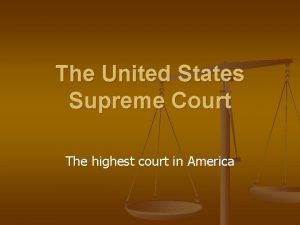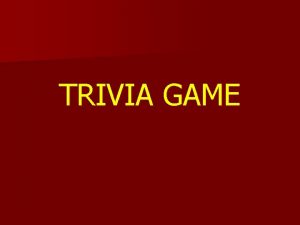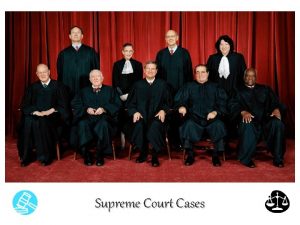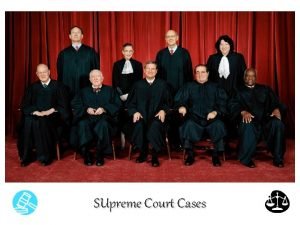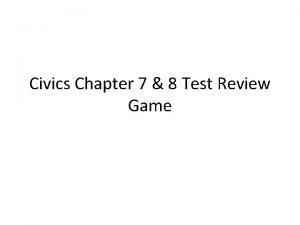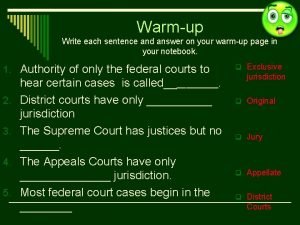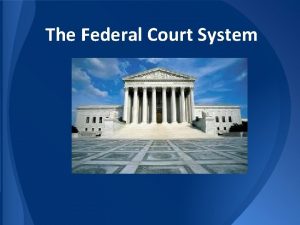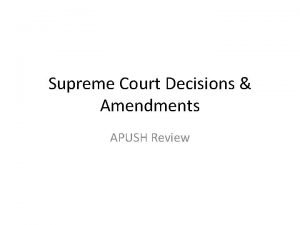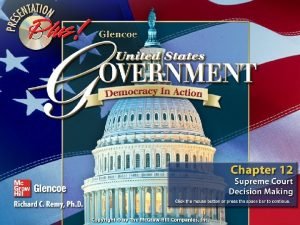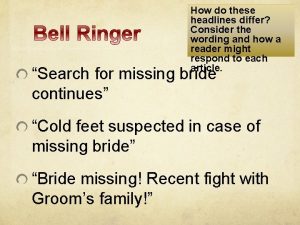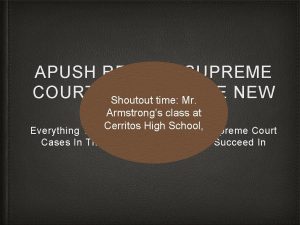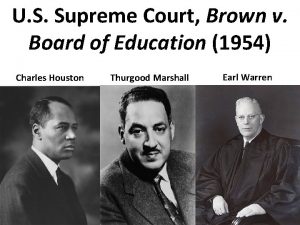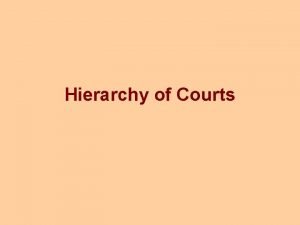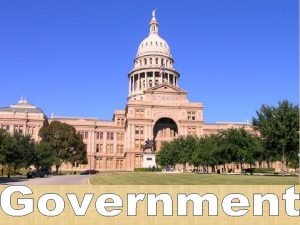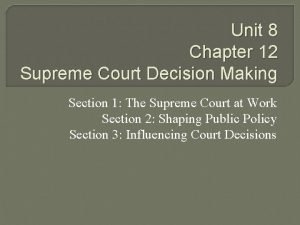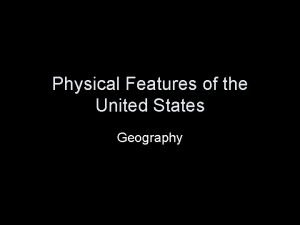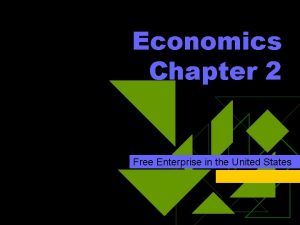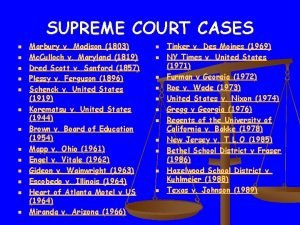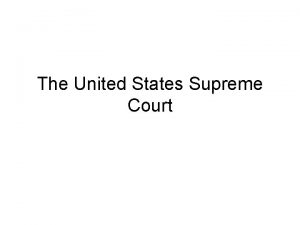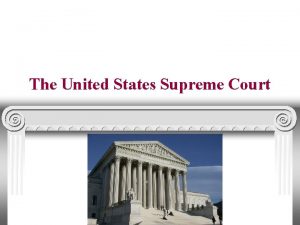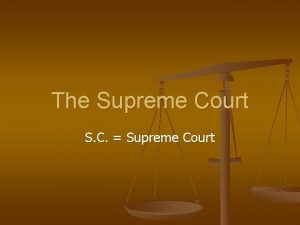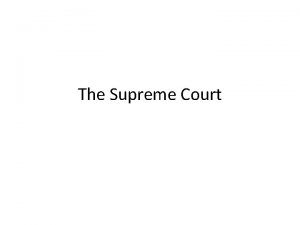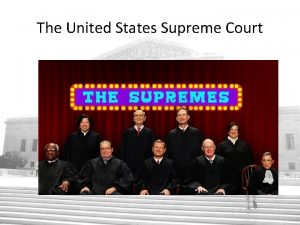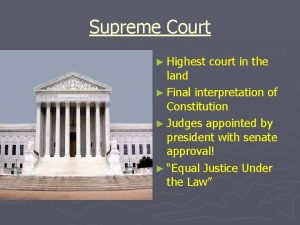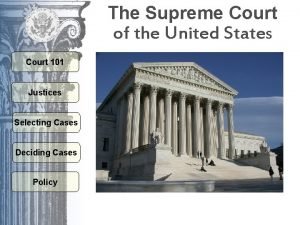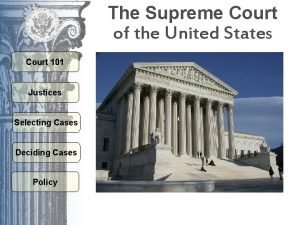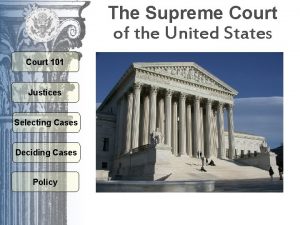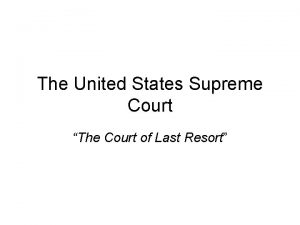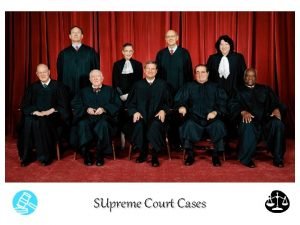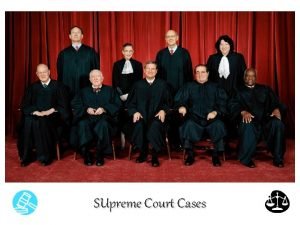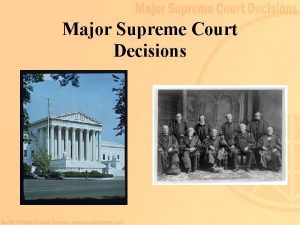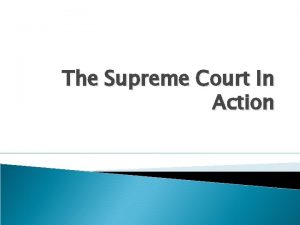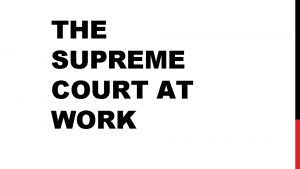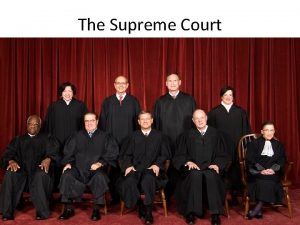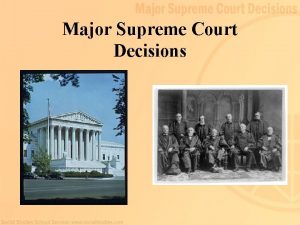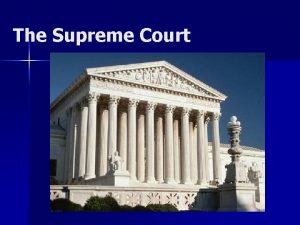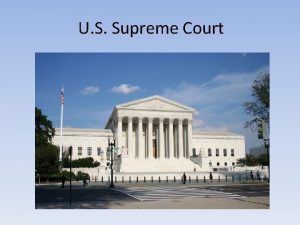The United States Supreme Court The Highest Court




























- Slides: 28

The United States Supreme Court The Highest Court in the United States of America

The Judicial Branch • Article III of the Constitution established the judicial branch of government headed by a national Supreme Court. • The primary function of the judicial branch is to interpret the Constitutionality of laws and other governmental actions.

Supreme Court Jurisdiction • The Supreme Court has both original and appellate jurisdiction. • The Supreme Court is the final authority on the Constitution and the laws of the United States.

Original Jurisdiction • The Supreme Court has original jurisdiction in cases involving ambassadors, maritime issues, cases where the United States is a party, cases between two or more states, etc… • These cases are rarely heard by the Supreme Court.

Appellate Jurisdiction • The Supreme Court receives over 6000 appeals cases per year. The Supreme Court actually hears around 150 of these cases.

Types of Appeals Cases • For the Supreme Court to accept a case on appeal there must be a significant legal or Constitutional question that must be decided. • The decision of the Supreme Court can’t be appealed.

Judicial Review • This is the power of the Supreme Court to review any federal or state law to see if it is in agreement with the Constitution. • If the Supreme Court finds a law to be unconstitutional it has the power to nullify the law.

Judicial Review Continued • The principle of judicial review was established in 1803 with the Supreme Court case of Marbury v. Madison.

Legislative Checks and Balances on the Supreme Court • The legislative branch can get around a ruling by changing a law so that it no longer conflicts with the Constitution. • Also, the legislative branch can initiate the amendment process which would change the Constitution and U. S. law.

Executive Checks and Balances on the Supreme Court • The executive branch can refuse to enforce the ruling of the Supreme Court.

Supreme Court Justices • There are nine justices on the Supreme Court. There is one chief justice and eight associate justices.

The Current Supreme Court

The Chief Justice John Roberts (Appointed by President George W. Bush in 2005)

Associate Justice Antonin Scalia (Appointed by President Reagan in 1986)

Associate Justice Anthony Kennedy (Appointed by President Reagan in 1988)

Associate Justice Clarence Thomas (Appointed by President George H. W. Bush in 1991)

Associate Justice Ruth Bader Ginsburg (Appointed by President Clinton in 1993)

Associate Justice Stephen Breyer (Appointed by President Clinton in 1994)

Associate Justice Samuel Alito (Appointed by President George W. Bush in 2006)

Associate Justice Sonia Sotomayor (Appointed by President Obama in 2009)

Associate Justice Elena Kagan (Appointed by President Obama in 2010)

Supreme Court Facts! • Supreme Court Justices are appointed by the President and approved by the Senate. • Supreme Court Justices serve for life. • The chief justice receives $217, 400 per year while the associate justices receive $208, 100.

Can you name any landmark or famous supreme Court Decisions?

Some Landmark Cases • Marbury v. Madison (1803) • Judicial Review, Federalism • Brown v. Board of Education (1954) • School Segregation, Equal Protection • Gideon v. Wainwright (1963) • Right to Counsel, Due Process • Miranda v. Arizona (1966) • Self-Incrimination, Due Process

Some Landmark Cases • Roe v. Wade (1973) • Abortion, Right to Privacy • United States v. Nixon (1974) • Watergate, Checks and Balances • New Jersey v. T. L. O. (1985) • Student Search & Seizure • Bush v. Gore (2000) • Florida Election Results, Equal Protection under 14 th amendment

Review……… Which Article of the Constitution created the Judicial Branch?

What types of jurisdiction does the Supreme Court have?

Name the current chief Justice of the Supreme Court.
 What is the highest court in the united states? *
What is the highest court in the united states? * Is there a basketball court above the supreme court
Is there a basketball court above the supreme court Cohens vs virginia apush
Cohens vs virginia apush Insular cases apush
Insular cases apush The u.s. supreme court works chiefly as a(n)
The u.s. supreme court works chiefly as a(n) How cases reach the supreme court worksheet answers
How cases reach the supreme court worksheet answers Victorian court hierarchy
Victorian court hierarchy Us circuit court map
Us circuit court map Which of these best summarizes the monroe doctrine?
Which of these best summarizes the monroe doctrine? Supreme court does
Supreme court does Warren court apush
Warren court apush Supreme court
Supreme court The supreme court change
The supreme court change John marshall supreme court
John marshall supreme court Supreme court does
Supreme court does What do these headlines say about how the supreme court
What do these headlines say about how the supreme court Schechter poultry v us apush
Schechter poultry v us apush Supreme court
Supreme court Hierarchy of criminal courts in india
Hierarchy of criminal courts in india John marshall supreme court
John marshall supreme court Have supreme court
Have supreme court Vocabulary activity 12 supreme court decision making
Vocabulary activity 12 supreme court decision making President help wanted poster
President help wanted poster When mr pirzada came to dine sparknotes
When mr pirzada came to dine sparknotes United states physical geography
United states physical geography Chapter 2 free enterprise in the united states answer key
Chapter 2 free enterprise in the united states answer key United states vietnam
United states vietnam Ep management aiesec
Ep management aiesec Mapp v. ohio
Mapp v. ohio
